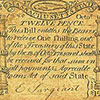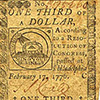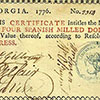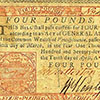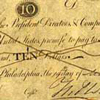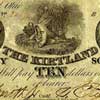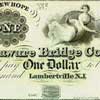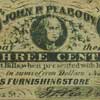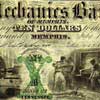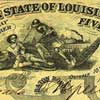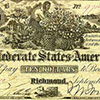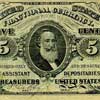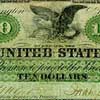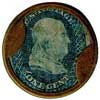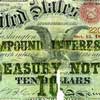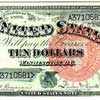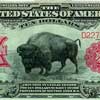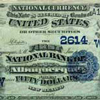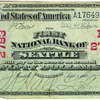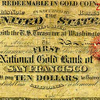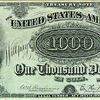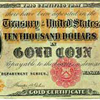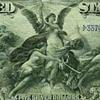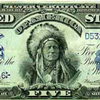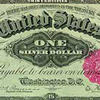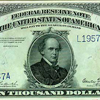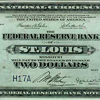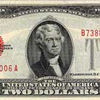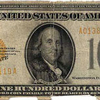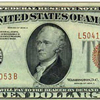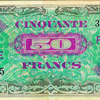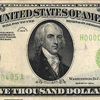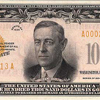Colonial Currency, Massachusetts, 12 Pence, 1776, Paper Money of the United States Page 218 states the image is courtesy of the Federal Reserve Bank of San Francisco and clearly shows that the reverse side of this note shows a tree and the words Printed by John Gill (Reference 1) (Reference 2).
Continental Currency, one-third dollar, 1776. Illustration on page 213 of Paper Money of the United States states the image is courtesy of the Federal Reserve Bank of San Francisco and clearly shows that note was printed by Hall & Sellers. Page 6 of Paper Money of the United States: “Beginning in mid-1775, the Continental Congress authorized the issuance of currency to finance the Revolutionary War. This became known as Continental Currency. The notes were redeemable in Spanish Milled Dollars but they depreciated to the point that they cost more to print.” Page 60, 61 of Greenback: “Hard redemption was planned in four installments of taxes after victory”. Page 62: “Franklin himself designed the mottoes and motifs on the four smallest bills, for fractions of a dollar. The first set was printed by Paul Revere.” Page 63: “Continentals sank like a stone as the British retreated and the rebellion now looked like a success. For everyone wondered now what on earth Congress would do or find to redeem the money.”
Colonial Currency, Georgia, $4, 1776
(Reference 1) (Reference 2).
Colonial Currency, Pennsylvania, 4 pounds, 1777 (Reference).
First Bank of the United States, $10, 1792 (Reference).
Mormon Kirtland Note, $10, Ohio,1837-1839. Greenback Page 185 “The Mormon leader Joseph Smith started a bank for the convenience of the faithful in Kirkland, Ohio, in 1836. The bills he issued tended to leak out beyond the Mormon community, and the gentiles were annoyed when Smith refused to redeem them for hard cash. When a Pittsburgh banker sent some notes back for redemption, the bank president tartly replied that he had issued notes for the convenience of the people, and to redeem them would defeat the purpose. The bank failed in 1837, with forty thousand dollars in notes outstanding, a major reason for deteriorating relations between the Mormons and the gentiles of Illinois in 1837. Once the faithful had grasped the mechanism, and removed to the Promised Land, Mormon banks proved to be extremely well run, and their dollar bills were universally accepted.”
Transportation Issue, Delaware Bridge Company, $1, 1836-1841
(Reference 1) (Reference 2)(Reference 3).
Private Issue, Peabody Ladies Furnishings, 3 cents 1862-1863.
(Reference)
Salem, MA- John P. Peabody Ladies Furnishing Store 2¢ Jan. 1, 1864. Peabody’s store was located at 220 Essex St. and this note was signed by Mr. Peabody. According to an ad he sold jewelry, silver ware, fans, perfumes, and toilet articles. The John P. Peabody residence at 15 Summer St. is listed on the National Register of Historic Places. J.H. Bufford, a lithographer in Boston, produced this note. Fine, torn.
Private Bank Note, Mechanics Bank, $10, 1854. See notes. Paper Money of the United States page 6: “…the United States was virtually blanketed by issues of State BankNotes. The country at this time was just beginning to prosper and grow, and it soon became apparent that there was insufficient money in actual circulation to meet the demands of trade and commerce. Consequently, the various States granted charters to many private banks in their jurisdiction, and b the terms of these State Charters the banks were authorized to print and circulate their own currency.”…onto concept of Broken Bank Notes…Note: There are MANY modern-day Mechanics Banks (Reference). Many people today lack appreciation of the origin of the Bank’s name. The founders and original customers represented various trades, crafts and professions in which the African American community had achieved success and prominence, so “Mechanics” likely was derived from the legal term “mechanics lien” that grouped such occupations together. Additionally, most of North Carolina ‘s wealth at the turn of the 20 the century was based on the ownership of real property, especially farmland, hence the term “Farmers.” That means the name “Mechanics and Farmers” denotes that this Bank is an institution dedicated to serving all facets of the community.
State Issue, Louisiana, $5, 1862. (Reference 1), (Reference 2). $5 Note with an allegorical representation of the South slaying the North. This note is known as the “lazy 5” note because of the sideways 5 at the bottom of the note.
Confederate Currency, $10, 1861. Paper Money of the United States page 238. “On result of secession was the immediate hoarding of United States coins, requiring the printing of a paper currency. Christopher Memminger [the Treasurer for the Confederate States of America] instituted a monetary plan for the new republic, geared for a young nation at peace. However, within months, the nation was at war, which accelerated after the first battle of Manassas in July, 1861. Eventually, the Confederacy was blockaded and cut off from most of the world, making foreign trade almost impossible. To finance the war, the Confederacy made subsequent monetary issues, through 1864. The result was rampant inflation. At Lee’s surrender at Appomattox, the currency was worthless.”
Fractional Currency, 5 cents, 1864. See emails on file from Bureau of Engraving & Printing Office of Historical Research and from the American Numismatic Association. See also Greenback pages 244-245.
Demand Note, $10, 1861. Paper Money of the United States pages 6 and 11. “Soon after the Civil War began, the United States found itself in desperate need for money to finance the war. The only remedy that could be found was in an issue of paper money. Accordingly, Congress passed the Act of July 17, 1861 which permitted the Treasury Department to print and circulated paper money to the extent of 60 million dollars. “The term Greenback for United States paper money originated with the issue of the Demand Notes of 1861. Demand Notes are the first and earliest issue of United States currency as we know it. “Printed in green. The green reverses of the
Demand Notes are the origin of the term ‘Greenback’ as applied to U.S. paper money in general.”
Postage Stamp, 1 cent, 1862-1863. Paper Money of the United States page 210: “Encased Postage Stamps.” Several paragraphs + identical illustration.
Compound Interest Note, $10, 1864. Paper Money of the United States page 35 (several paragraphs).
Legal Tender Note, $10, 1880. (Reference 1) (Reference 2) (Reference 3), Paper Money of the United States pages 14-34
Legal Tender Note, $10, 1901 (Reference). American Buffalo pages 12-15. See email from American Buffalo author Steven Rinella. Paper Money of the United States page 23: “Bison between the explorers Meriwether Lewis and William Clark. There is dispute over whether the bison is Black Diamond, the animal on the reverse of the Indian Head nickel, or Pablo, a bison which resided at the Washington Zoo.”
National Bank Note, National Bank of South Reading, Massachusetts, $2, 1865. Paper Money of the United States page 77. “Notes of this period rank among the most beautiful examples of American currency. The obverses bear vignettes pertaining to America history or tradition; the reverses show some of the famous paintings on Americana that hang in the Capital at Washington.” Paper Money of the United States page 79. “Woman holding flag. This is the well known ‘Lazy 2’ note, so called because of the extreme horizontal shape of the 2.” Stack’s page 88.
National Bank Note, First National Bank of Albuquerque, $50, 1912. Paper Money of the United States pages 75, 87 (numerous paragraphs) (Reference).
National Bank Note, First National Bank of Seattle, $50, 1902. Paper Money of the United States pages 103, 113: “Notes of the Third Charter Period”
National Bank Note, First National Gold Bank of San Francisco, $10, 1870. Paper Money of the United States page 133
Treasury Coin Note, $1,000, 1890. Stack’s page 69: “The ‘Watermelon’ notes of 1890 (so-called because of the shape of the zeros on the back) are among the most famous and most popular. In fact, the highest price ever realized by a piece of paper money at public auction is held by the $1,000 Watermelon we sold a few years ago.” Paper Money of the United States page 67: Treasury or Coin Notes: “The notes of the 1890 Series are especially attractive because of the intricate designs on the reverse. The 1890 notes are all rare today, especially in new condition. Paper Money of the United States page 74: “The Grand Watermelon. From the collection of the Federal Reserve Bank of San Francisco. Only 25 notes are outstanding of this design.”
Gold Certificate, $10,000, 1882. Paper Money of the United States page 145 with photo of obverse and reverse. “Note illustrated from the collection of the Federal Reserve Bank of San Francisco. Signatures Teehee and Burke. Extremely rare. Two known.” Paper Money of the United States page 136. “Gold Certificates are color and vivid and are among the most attractive of all currency issues. Their reverses are brilliant golden orange, symbolic of the gold coin they represent.”
Silver Certificate, $5, 1896. See emails from BEP Office of Historical Research and ANA Curator.
Silver Certificate, $5, 1899. Curators at the Smithsonian have confirmed that the war bonnet on this note is typical of those worn by numerous plains tribes of the day and cannot conclusively be identified with either the Sioux or the Pawnee tribe. See email from Smithsonian (Reference).
Silver Certificate, $1, 1886
(Reference 1)
(Reference 2, Paper Money of the United States: pages 50, 51, 22, 82).
Federal Reserve Note, $10,000, 1914. Paper Money of the United States page 132 (Reference).
Federal Reserve Bank Note, $2, 1918.
(Reference 1)
(Reference 2),
(Reference 3).
Legal Tender Note, $2, 1928 (Reference).
Gold Certificate, $100, 1928. Paper Money of the United States page 208: “Gold Certificates. All are now obsolete. The issue was short lived as the Gold Reserve Act of 1933 required the surrender of all gold certificates. On April 24, 1964 Secretary of the Treasury C. Douglas Dillon removed all restrictions on the acquisition or holding of gold certificates and it is now legal to collect them.”
(Reference 1) (Reference 2) (Reference 3) (Reference 4),
Federal Reserve Note, Hawaii, $10, 1934
(Reference 1)
(Reference 2).
Allied Military Currency, Provisional French Currency, 50 francs
(Reference 1)
(Reference 2).
Federal Reserve Note, $5,000, 1934
(Reference 1)
(Reference 2).
Bank Transfer Note, $100,000, 1934
(Reference 1)
(Reference 2).
